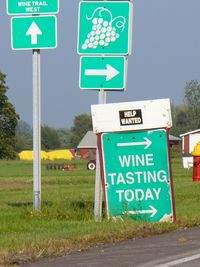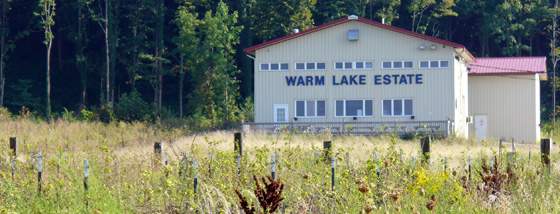Driving past the “Wine Tasting Today” sign on the side of Lower Mountain Road in Cambria, I’m reminded of my first months in the Niagara Region – a feeling that’s compounded when my eyes invariably train toward the “Help Wanted” sign right next to it.
It’s the same sign that I read four years ago that led me to my first job in the wine industry. As I follow the arrows pointing up the hill toward Warm Lake Estate’s tasting room, I don’t remember the road being as potholed and bumpy as it somehow feels today. When the winery itself looms into view, what I’d been hearing is seemingly confirmed: Warm Lake Estate has stopped production.
 It’s not so much the desolate parking lot that leads me to the conclusion that operations have ceased so much as the 35 acres of neglected vineyards. I’m reminded of that dystopian Discovery Channel show “Life After People” as I pull up and snap a few photos of overgrown weeds and decaying clusters left on the vine from the previous growing season. The winery, once open seven days a week, is locked up in the middle of a sunny summer day.
It’s not so much the desolate parking lot that leads me to the conclusion that operations have ceased so much as the 35 acres of neglected vineyards. I’m reminded of that dystopian Discovery Channel show “Life After People” as I pull up and snap a few photos of overgrown weeds and decaying clusters left on the vine from the previous growing season. The winery, once open seven days a week, is locked up in the middle of a sunny summer day.
A quick phone call to its listed number indicates the line has been disconnected.
When my wife and I moved to the Niagara Region from New York City in 2007, these vineyards looked nothing like they do today. The winery’s outlook was fairly positive. Warm Lake was still selling its 2005 vintage for $40 a bottle while still ultimately making a case for pinot noir on the Niagara Escarpment; the 88-point score from Wine Spectator definitely didn’t hurt its fledgling reputation.
Back then there weren’t a dozen wineries educating their customers on the microclimate created by the escarpment and Lake Ontario, and the benefits of limestone soils or talking about clay versus sand or gravel.
Today, the outlook for Warm Lake doesn't appear as bright. Even after successfully raising enough money to plant the largest continuous planting of pinot noir east of the Rockies, building a winery filled with vats and the best oak barrels you can buy, receiving the highest Wine Spectator score for a pinot noir from New York and after inextricably tying the name “Warm Lake” to the Niagara Escarpment region, it appears as if the rumors of an investor buyout, restructuring and ceasing of production are true.
I personally don’t place all that much importance on why or how it happened so soon — especially because the Niagara Wine Trail itself is booming. I see it like the details of a bad divorce whereby at the end of the day the result is the same no matter who’s fault it was or what series of events led to it.
Put simply, I think the winery was before its time, and it tried to be too big, too fast and too soon.
How do you market a $40 bottle of wine from an unknown region tens of thousands of times? I’m not sure anyone could have pulled that off in Niagara back in 2007. So when I look at what Mike Von Heckler did with Warm Lake I view his accomplishments in the broader sense: he established an AVA, helped to form the wine trail as it is today, planted an amazing vineyard on prime Escarpment land and placed Niagara wines on the radar of yours truly.
Hell, I was sold on the region enough to move here and buy land.
Before I started contributing to the NYCR, most everyone I’d met in the Finger Lakes and Long Island knew Niagara only as Warm Lake Estate; the two were synonymous and virtually interchangeable. I’d commonly get questions like, “What’s the deal with Warm Lake?” “How’s Mike doing?” “You have that pinot noir winery there, right?”
Indeed, for better or for worse, Niagara’s fate and Warm Lake’s were intertwined.
In my opinion when Warm Lake started having consistency issues with a tough 2006 vintage — including but not limited to early browning from early pH levels being too high — retailers and customers that committed to orders and futures orders seemed to start jumping off the bandwagon. Any momentum from previous vintages was lost and the news of dissatisfied customers spread quickly.
Since then, anytime I’ve poured or talked about Niagara pinot noir, people’s expectations have been based on the worst vintages of Warm Lake wines. Snarky comments like “at least its red” were a favorite and I came to realize that marketing pinot noir, even under a different brand name here would be an uphill battle.
Since I still pour in a tasting room down the road I get questions weekly about the winery. These days, the most common revolves around why there’s a wine tasting sign out if they’re closed. But many are interested in what happened and why. I usually just mention that there were a lot of grapes to take care of and a lot of wine to make without a large trained staff.
What’s done is done, though and the region is looking forward, even as the future of Warm Lake remains uncertain. From conversations I’ve had with people close to the situation -– but who also want to remain anonymous –- the winery’s short-term goal is to get the vineyards back in shape and sell grapes as it works toward going back into production under a different name.
 I see the distribution of their grapes to a variety of winemakers across the state the best possible scenario for improving the image of pinot noir here.
I see the distribution of their grapes to a variety of winemakers across the state the best possible scenario for improving the image of pinot noir here.
Driving back down the hill away from the winery you can almost see and feel the hopes and dreams that were lost when these vines stopped being cared for.
I recall my first experiences cleaning barrels and talking about the geology of the escarpment with visitors for the month I spent employed here. I remember thinking that the winery and the region itself is such a cool story that the only thing it needed was people to get the story out and the business side would work itself out.
Having a more realistic view of the industry today I know that it’s just not that simple and I realize that no one winery will define this diverse region. But with the possibility of Warm Lake’s grapes being spread out among wineries and in the hands of careful winemakers, it may ultimately help strengthen the case for Niagara pinot noir once again.

